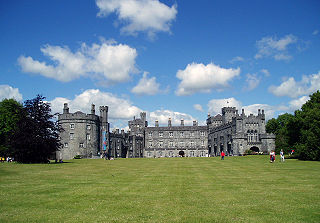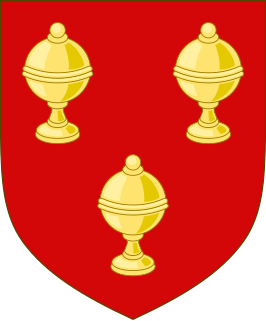Related Research Articles

Thomas Boleyn, 1st Earl of Wiltshire, 1st Earl of Ormond, 1st Viscount RochfordKGKB, of Hever Castle in Kent, was an English diplomat and politician who was the father of Anne Boleyn, Queen Consort and the second wife of King Henry VIII, and was thus the maternal grandfather of Queen Elizabeth I of England.

James FitzJames Butler, 2nd Duke of Ormonde, was an Irish statesman and soldier. He was the third of the Kilcash branch of the family to inherit the earldom of Ormond. Like his grandfather the 1st Duke, he was raised as a Protestant, unlike his extended family who held to Roman Catholicism. He served in the campaign to put down the Monmouth Rebellion, in the Williamite War in Ireland, in the Nine Years' War and in the War of the Spanish Succession but was accused of treason and went into exile after the Jacobite rising of 1715.

Kilkenny Castle is a castle in Kilkenny, Ireland built in 1195 to control a fording-point of the River Nore and the junction of several routeways. It was a symbol of Norman occupation and in its original thirteenth-century condition it would have formed an important element of the defences of the town with four large circular corner towers and a massive ditch, part of which can still be seen today on the Parade.

Vice-Admiral Thomas Butler, 6th Earl of Ossory, KG, PC, PC(I) (1634–1680) was an Irish politician. He was born at Kilkenny Castle, the eldest son of James Butler, 1st Duke of Ormond, and Lady Elizabeth Preston.

The peerage title Earl of Ormond and the related titles Duke of Ormonde and Marquess of Ormonde have a long and complex history. An earldom of Ormond has been created three times in the Peerage of Ireland.

Thomas Butler, 10th Earl of Ormonde, 3rd Earl of Ossory, Viscount Thurles, was an Irish peer and the son of James Butler, 9th Earl of Ormond and Lady Joan Fitzgerald daughter and heiress-general of James FitzGerald, 10th Earl of Desmond. He was Lord Treasurer of Ireland and a very prominent personage during the latter part of the 16th century.
Piers Butler, 8th Earl of Ormond, 1st Earl of Ossory also known as Red Piers, was from the Polestown branch of the Butler family of Ireland.
James Hubert Theobald Charles Butler, 7th Marquess of Ormonde, MBE was the son of Reverend Lord James Theobald Bagot John Butler and Lady Annabella Brydon Gordon. He was the 7th and last holder of the title Marquess of Ormonde and the 25th holder of the title Earl of Ormond. The title Earl of Ormond is one of the oldest titles in the peerages in the British Isles, having first been granted to James Butler, 1st Earl of Ormond, who married a granddaughter of Edward I of England.
John Butler, 17th Earl of Ormonde, 10th Earl of Ossory (1740–1795) was an Irish peer and Member of Parliament (MP). He represented Gowran between 1776 and 1783, and Kilkenny City between 1783 and 1792. In 1791, his right to the peerage was acknowledged in the Irish House of Lords.
Walter Butler (1703–1783), also known as Walter Butler of Kilcash, and Walter Butler of Garryricken, was the de jure16th Earl of Ormond and 9th Earl of Ossory. He did not assume these titles as he thought them forfeit as a result of the attainder of the 2nd Duke of Ormonde. In the peerage of Ireland, the titles were successfully claimed in 1791 by his son John, the 17th Earl.
John Butler, known as John Butler of Kilcash, a member of the Irish landed gentry, was de jure the 15th Earl of Ormonde and the 8th Earl of Ossory. He did not assume these titles as he thought them forfeit as a result of the attainder of the 2nd Duke of Ormond. He did, however, inherit the Ormond estate from the 1st Earl of Arran. In 1791, the title of Earl of Ormond would be successfully claimed by his cousin, the 17th Earl.
Walter Butler, 11th Earl of Ormond and 4th Earl of Ossory, was an Irish peer. He was the son of John Butler of Kilcash and Katherine, the daughter of Cormac na Haoine MacCarthy Reagh. He inherited the earldom in 1614 because his uncle Thomas had died without legitimate male issue. Following the failure of the senior line, Walter's Kilcash branch would supply five earls of Ormond.

James Butler, 9th Earl of Ormond and 2nd Earl of Ossory, known as The Lame, was the son of Piers Butler, 8th Earl of Ormond and Margaret Fitzgerald, Countess of Ormond. He was created, in 1535, Viscount Thurles, and was confirmed by Act of Parliament, 6 November 1541, in the Earldom of Ormond, as 9th Earl with the pre-eminence of the original earls. His death by poisoning in London has remained an unsolved mystery to this day.
Thomas Butler, 7th Earl of Ormond, P.C. was the youngest son of James Butler, 4th Earl of Ormond. He was attainted, but restored by Henry VII' s first Parliament in November 1485, and the statutes made at Westminster, by Edward IV, which declared him and his brothers traitors, were abrogated.
James Butler, 4th Earl of Ormond was the son of James Butler, 3rd Earl of Ormond. He was called 'The White Earl' and was esteemed for his learning. He was the patron of the Irish literary work, 'The Book of the White Earl'. His career was marked by his long and bitter feud with the Talbot family.

Lady Margaret Butler, Lady Boleyn was an Irish noblewoman, the daughter and co-heiress of Thomas Butler, 7th Earl of Ormond. She married Sir William Boleyn and through her eldest son Sir Thomas Boleyn, was the paternal grandmother of Anne Boleyn, second wife of King Henry VIII of England, and great-grandmother of Anne and Henry's daughter, Elizabeth I of England.
Anne Hankford was the first wife of Thomas Butler, 7th Earl of Ormond. She was the great-grandmother of Anne Boleyn

Margaret FitzGerald, Countess of Ormond, Countess of Ossory was an Irish noblewoman and a member of the powerful and celebrated FitzGerald dynasty also known as "The Geraldines". She married Piers Butler, 8th Earl of Ormond, by whom she had four sons and five daughters.

The Butler family were landowners who were for several centuries prominent in the administration of the Kingdom of Ireland. Variant spellings of the name include le Boteler and le Botiller.
Mary Butler, Duchess of Ormonde was the second wife of James Butler, 2nd Duke of Ormonde.
References
- ↑ Steven G. Ellis (17 June 2014). Ireland in the Age of the Tudors, 1447-1603: English Expansion and the End of Gaelic Rule. Routledge. p. 4. ISBN 978-1-317-90143-3.
- ↑ Great Britain. Record Commission (1830). State Papers: Published Under the Authority of His Majesty's Commission. King Henry the Eighth. G. Eyre and A. Strahan, printers to the King's Most Excellent Majesty. pp. 301.
| This biography of a member of a noble house or article about nobility is a stub. You can help Wikipedia by expanding it. |